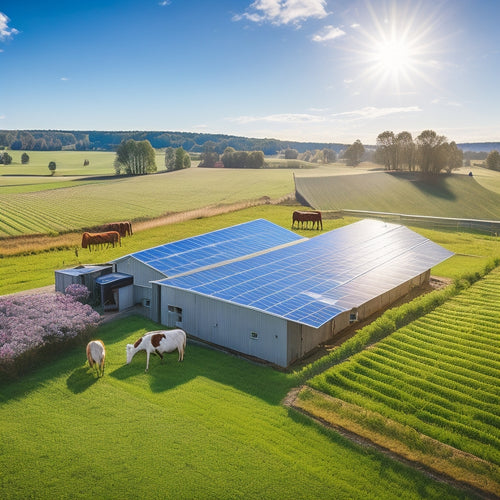
Average Cost of a Tiny House Solar System
Share
The average cost of a tiny house solar system typically ranges from $10,000 to $30,000. This depends on factors such as system size, component selection, and installation complexity. Investing in solar technology offers significant long-term savings on energy bills, along with tax incentives that can offset upfront expenses. Components include solar panels, inverters, and battery storage, each impacting overall efficiency and cost. Understanding your energy needs will guide you in selecting the right system for your tiny home. If you're interested in maximizing your investment and energy efficiency, further knowledge is available to investigate.
At a Glance
- The average cost of a tiny house solar system ranges from $10,000 to $30,000, depending on size and complexity.
- Professional installation ensures compliance with safety standards, influencing total installation costs.
- Solar systems can lead to monthly energy savings between $50 to $175, enhancing financial benefits over time.
- Tax incentives and rebates can significantly offset initial costs, improving return on investment for solar energy.
- Ongoing maintenance costs are low, primarily involving regular cleaning and occasional battery replacements every 5 to 15 years.
Energy Independence and Sustainability
Achieving energy independence through a tiny house solar system allows you to utilize renewable resources, reducing reliance on traditional power grids.
This change not only lowers your energy costs but also aligns with sustainable living practices that minimize your environmental footprint.
By shifting to solar power, you can enjoy long-term savings that contribute to your financial well-being, while also promoting the benefits of solar energy that enhance home value and reduce carbon emissions.
Embracing this approach enables you to make informed decisions that contribute to a more sustainable future.
Benefits of Energy Independence
While many homeowners seek to reduce their reliance on traditional energy sources, embracing energy independence through a tiny house solar system offers significant advantages. By utilizing renewable resources, you can utilize solar energy to power your home, leading to lower utility bills and reduced carbon footprints. This approach not only promotes sustainability but also enhances your energy freedom.
With a solar system, you're less susceptible to fluctuating energy prices and outages, enabling you to take control of your energy consumption. This independence allows you to customize your energy usage according to your needs, whether it's powering appliances, heating, or cooling your space. You're not just a passive consumer; you become an active participant in generating your own energy.
Moreover, investing in a tiny house solar system provides long-term financial benefits. After the initial investment, ongoing maintenance costs are minimal, and you often benefit from government incentives or rebates.
Essentially, by committing to energy independence, you're not just saving money; you're encouraging a lifestyle that aligns with your values, prioritizing renewable resources, and ensuring a sustainable future for yourself and the planet.
Sustainable Living Practices
Embracing energy independence naturally leads to a broader commitment to sustainable living practices.
By investing in a tiny house solar system, you're not just generating renewable energy; you're also laying the groundwork for a minimalist lifestyle rooted in eco-friendly principles.
Sustainable design is essential here—consider using green building techniques and eco-friendly materials to construct your home.
As you aim for off-grid living, energy-efficient appliances become imperative. They reduce your energy consumption and help maintain your autonomy from traditional power sources.
Implementing urban gardening and permaculture practices can further enhance your sustainability efforts, creating a self-sufficient food source while minimizing your carbon footprint.
Water conservation methods, such as rainwater harvesting and greywater recycling, play a significant role in your sustainable lifestyle.
These practices guarantee you use water responsibly, complementing your renewable energy efforts.
Cost Savings on Electricity
By installing a tiny house solar system, you can greatly reduce your energy bills each month.
Small home solar systems can cut carbon emissions by up to 3,000 lbs annually, further enhancing their appeal as an eco-friendly energy solution.
Over time, these savings accumulate, providing long-term financial benefits that outweigh the initial investment.
Understanding these cost savings is essential for maximizing the value of your solar system, especially considering the potential for monthly savings ranging from $50 to $175.
Reduced Energy Bills
Reducing energy bills is one of the most persuasive reasons to install a solar system on your tiny house. With the right setup, you can considerably cut your electricity expenses, giving you greater financial freedom.
By utilizing solar energy, you're not just investing in a system; you're enhancing your home's energy efficiency. This means less reliance on conventional utility sources, which often come with fluctuating prices.
Utility incentives can further sweeten the deal. Many local governments and energy providers offer rebates or tax credits for solar installations, which can offset your upfront costs. This allows you to start saving on your energy bills almost immediately.
In addition, as solar technology continues to advance, the efficiency of panels improves, meaning you can generate more energy from the same amount of sunlight. The combination of energy efficiency and utility incentives can create a powerful financial advantage.
Ultimately, with reduced energy bills, you gain more control over your budget and can allocate resources to other meaningful pursuits, aligning with your desire for autonomy and a sustainable lifestyle.
Embracing solar energy isn't just an investment in your tiny house; it's a step toward a freer, more self-sufficient future.
Long-Term Financial Benefits
Investing in a tiny house solar system can lead to significant long-term financial benefits, particularly regarding cost savings on electricity. By utilizing solar energy, you can drastically reduce or even eliminate your monthly electricity bills. Over time, these savings can accumulate, making your initial investment more than worthwhile.
When considering financing options, many lenders offer favorable terms for solar installations, allowing you to spread the cost over several years. This can make the shift to solar energy not only feasible but also financially advantageous. Additionally, numerous states and local governments provide tax incentives for solar energy adoption. These incentives can further lower your upfront costs and enhance the overall return on investment.
Moreover, as energy prices continue to rise, your savings will only increase, allowing you to enjoy a more predictable and manageable budget. By generating your own electricity, you also gain independence from utility companies, which can be a significant psychological and financial relief.
In the long run, the combination of reduced energy costs, financing options, and tax incentives positions a tiny house solar system as a smart investment for those seeking financial freedom and sustainability.
System Components Overview
When considering a tiny house solar system, understanding the essential components is vital for effective energy generation.
Key elements include solar panels, inverters, and battery storage systems, which together create a reliable energy solution.
You'll need to evaluate both the installation and maintenance costs associated with each part to gauge your overall investment.
This overview will help you make informed decisions about your solar setup and its long-term viability, especially when considering battery types and benefits.
Essential Components Breakdown
To effectively employ solar energy for your tiny house, understanding the essential components of a solar system is important. The core elements include solar panels, battery storage, inverters, and charge controllers.
When selecting solar panel types, you'll encounter monocrystalline, polycrystalline, and thin-film panels. Monocrystalline panels are known for their high efficiency and space-saving design, making them ideal for limited rooftops.
Polycrystalline panels are more budget-friendly but slightly less efficient, while thin-film panels offer flexibility and lightweight options, though they require more space.
Battery storage is equally significant, as it allows you to store excess energy generated during sunny days for use at night or during cloudy periods.
Lithium-ion batteries are popular for their longevity and efficiency, while lead-acid batteries are a more cost-effective choice but come with a shorter lifespan.
Inverters convert the direct current (DC) from the solar panels into alternating current (AC) for your appliances, and charge controllers guarantee your batteries don't overcharge, prolonging their lifespan.
Installation and Maintenance Costs
Understanding the installation and maintenance costs associated with a tiny house solar system is vital for budgeting and long-term planning.
The installation process involves several key components, including solar panels, inverters, batteries, and wiring. Typically, you can expect to pay between $10,000 to $30,000 for a complete installation, depending on the system size and complexity. Hiring a professional installer can add to your costs, but it guarantees adherence to safety standards.
Once your system is up and running, ongoing maintenance costs are relatively low. Regularly cleaning your solar panels and checking for debris buildup is essential.
Maintenance tips include monitoring your system's performance through monitoring apps and planning for battery replacement every 5 to 15 years, depending on your battery type.
Additionally, budgeting for potential repairs is wise, as equipment can wear over time.
By understanding these costs, you can make certain your tiny house solar system remains efficient and reliable, granting you the freedom to live sustainably without unexpected financial burdens.
This proactive approach will enable you to enjoy your energy independence fully.
Selecting Based on Energy Demand
To effectively select a solar system for your tiny house, you first need to assess your energy consumption.
Understanding your daily energy use will help you evaluate your solar needs and determine the appropriate system size. By aligning your energy demand with solar capabilities, you guarantee peak efficiency and performance.
Additionally, considering energy-efficient upgrades can further enhance your system's effectiveness and reduce overall energy consumption.
This thorough evaluation is essential for a sustainable and cost-effective solar setup.
Assessing Energy Consumption
When planning your tiny house solar system, evaluating your energy consumption is essential to selecting the right setup for your needs. Start by conducting thorough energy monitoring to understand your current usage. Track your daily consumption patterns over a few weeks, noting the wattage of appliances and devices you regularly use. This data helps you identify peak usage times and high-energy devices, allowing you to make informed decisions.
Once you've gathered this information, categorize your energy needs into essential and non-essential loads. Prioritize critical systems, like refrigeration and lighting, over luxury items. This approach not only aids in sizing your solar system appropriately but also aligns your energy strategy with your lifestyle choices.
Consider future energy demands as well. If you plan to add more devices or appliances, factor these into your calculations to avoid undersizing your system.
Evaluating Solar Needs
Evaluating your solar needs is vital for guaranteeing your tiny house runs smoothly and efficiently. Start by analyzing your energy consumption patterns; this helps you determine the size and capacity of the solar system required.
Consider the solar energy trends, which are shifting towards more efficient and compact technologies—perfect for innovative tiny house designs.
Identify your peak energy demand, including appliances and systems you'll be using simultaneously. For instance, if you plan to run a refrigerator, lights, and a heater, calculate the total wattage to determine the necessary solar panel output.
Factor in seasonal variations in sunlight exposure, as this impacts energy production.
You should also consider your energy independence goals. If you aim to live off-grid, you'll need a system that can store enough energy to power your home during less sunny periods. Investigating battery storage options is essential for maintaining reliability.
Ultimately, the more precise you're when evaluating your solar needs, the better equipped you'll be to select a system that aligns with your freedom-focused lifestyle.
This careful planning guarantees that you utilize the full potential of solar energy, making your tiny home a sustainable haven.
Lower Carbon Footprint Impact
By adopting a tiny house solar system, you markedly reduce your energy emissions compared to traditional energy sources.
Your reliance on renewable energy not only lessens your carbon footprint but also contributes to a more sustainable environment.
Understanding the impact of your energy choices is vital for minimizing emissions and promoting eco-friendly living.
Reduced Energy Emissions
Integrating a solar system into your tiny house considerably reduces energy emissions, contributing to a lower carbon footprint. By utilizing renewable energy, you directly minimize reliance on fossil fuels, leading to significant emission reduction. Each kilowatt-hour of solar power offsets traditional energy sources, decreasing greenhouse gas emissions associated with conventional electricity production.
When you choose solar, you're not just generating clean energy for your home; you're actively participating in a broader movement toward sustainability and environmental stewardship. This shift means less pollution and a healthier planet for future generations. Additionally, considering the compact nature of tiny homes, the impact of your solar system is magnified.
Investing in a solar system enables you to take control of your energy consumption, reducing your dependence on utility companies and volatile energy prices. Plus, many systems are designed for efficiency, ensuring you maximize the energy captured from sunlight.
The combination of reduced energy emissions and independence from traditional energy sources is liberating, allowing you to accept a lifestyle aligned with ecological principles. Ultimately, a tiny house solar system not only enhances your freedom but also nurtures a cleaner, more sustainable world.
Frequently Asked Questions
What Financing Options Are Available for Tiny House Solar Systems?
You've got several financing options for tiny house solar systems. Consider solar loans, which often offer low-interest rates, and factor in potential energy savings. This approach enhances your independence while reducing long-term energy costs.
How Long Does It Take to Install a Tiny House Solar System?
Installing a tiny house solar system can feel like watching grass grow, but typically, the installation timeline spans one to three days, depending on the complexity and the number of solar system components you choose.
Can I Install a Solar System Myself for My Tiny House?
Yes, you can install a solar system yourself. Start by researching solar system components and gather DIY installation tips. With careful planning and safety precautions, you'll gain energy independence and enhance your tiny house's freedom.
What Maintenance Is Required for a Tiny House Solar System?
Did you know that 90% of solar panel issues stem from improper maintenance? You'll need regular solar panel upkeep, including cleaning, and battery maintenance checks to guarantee your tiny house solar system runs efficiently and sustainably.
Are There Any Government Incentives for Tiny House Solar Installations?
Yes, there're tax credits available for tiny house solar installations. These incentives promote renewable energy usage, reducing your overall costs. By utilizing such programs, you can enhance your energy independence and financial freedom.
Explore More
In the dance of energy independence, a tiny house solar system becomes your partner, guiding you toward sustainable living. You're not just cutting costs on electricity; you're crafting a greener future with every sunbeam captured. By understanding system components and tailoring them to your energy needs, you're reducing your carbon footprint. Welcome this expedition—it's not merely an investment; it's a commitment to a brighter, cleaner tomorrow. So, step forward and let the sun illuminate your path.
Related Posts
-

What Do I Need to Know About Farm Solar Panels
When considering farm solar panels, you need to assess costs, benefits, and technical specifics. Initial investment c...
-

Smart Home Thermostats to Revolutionize Your Space
Smart home thermostats revolutionize your space by providing precise temperature control and optimizing energy saving...
-

Replacing Old Appliances With Sustainable Alternatives
Replacing old appliances with sustainable alternatives can change your home into an energy-efficient space. Not only ...


